Report

This article is part of Bain's report on Buy Now, Pay Later in the UK.
Benefits and criticisms of BNPL have emerged on several fronts. On the one hand, these services unlock purchasing power, helping customers manage their finances by accessing affordable, low-cost credit. On the other hand, questions have been raised around their impact on households’ debt loads. But what do consumers and merchants actually experience? To cut through the conjecture, our research shines a brighter light on the advantages and challenges of using this form of payment.
How BNPL benefits consumers
Understanding the realities of how people engage with BNPL products will be instrumental to regulating the industry proportionately and without prejudicing the interests of consumers. We estimate that approximately 10.1 million people in the UK have used BNPL in the past 12 months. Our survey of more than 2,000 UK consumers found that general consumer satisfaction has propelled the growth in adoption and usage of BNPL. When we asked respondents how likely they were to recommend the consumer credit products they use to a friend, they clearly viewed the BNPL experience as better than that of credit cards or overdrafts (see Figure 11). Only 8% preferred to use a credit card or overdraft when a BNPL option is available.


These views reflect a wide range of user benefits, with the following benefits being the most important.
Cost savings relative to credit cards, even for users who miss a payment. The absence of fees or interest was the single most common benefit named by respondents; 52% cited it as one of the top three reasons for using these services. Had all BNPL purchases in the UK over the past 12 months been conducted using rolled-over credit card debt, the equivalent interest paid by customers would amount to approximately £103 million. The UK paid roughly £5.6 billion in total credit card interest in 2020. BNPL providers are able to subsidize or eliminate short-term borrowing costs for consumers by charging merchants a fee. This model has allowed providers to fundamentally change the structure of consumer credit. The absence of interest and self-imposed (not legally imposed) caps on late fees also incentivizes providers against allowing unpaid balances or rolled-over debt, as often happens with credit cards. Providers prefer to spur greater usage but with timely repayments; for example, users typically are barred from making further purchases if they leave an installment unpaid.
The UK paid roughly £5.6 billion in total credit card interest in 2020.
While differences in operating models make like-for-like comparisons difficult, in most analogous situations, BNPL is a more cost-effective method of borrowing than traditional alternatives (see Figure 12).
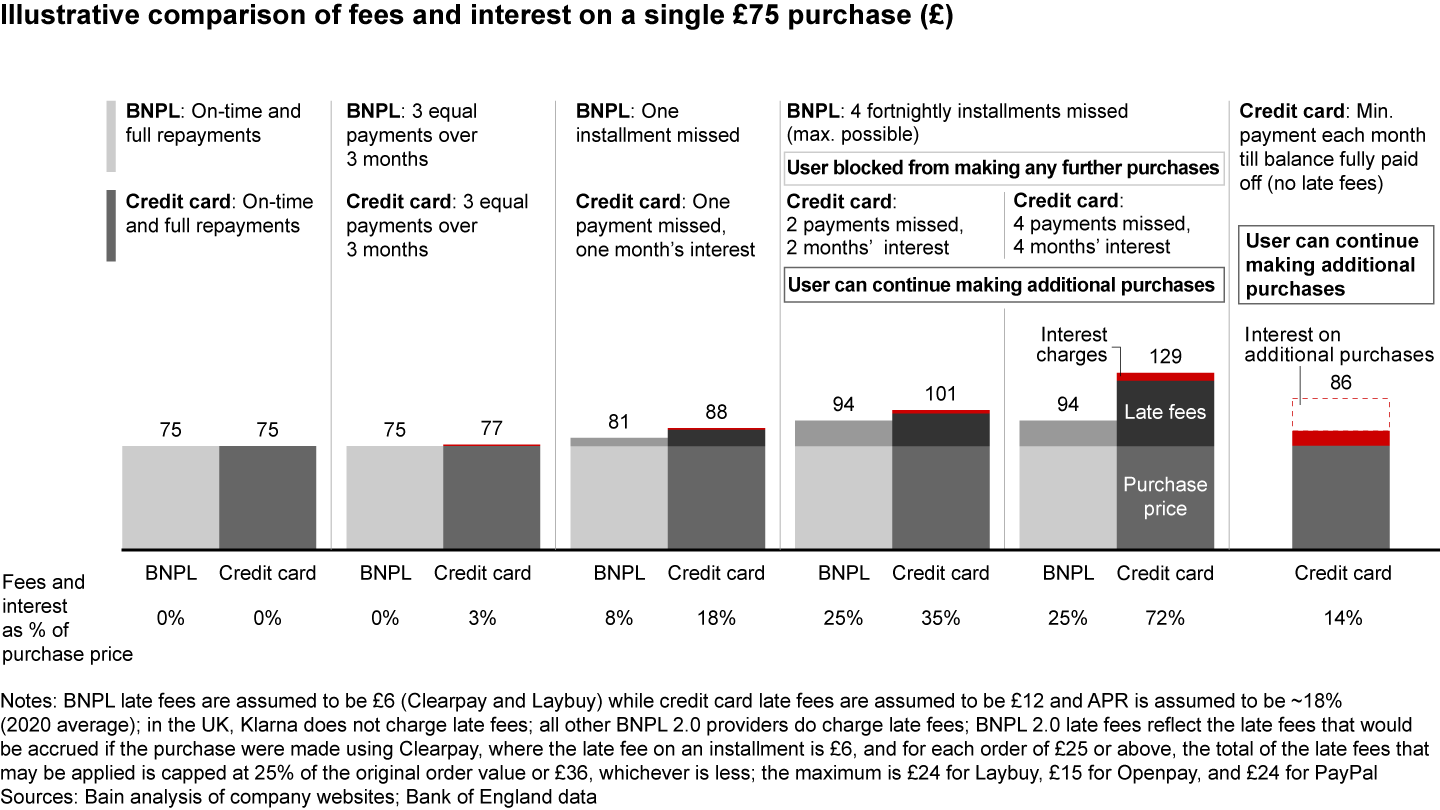

Help with managing finances and making important purchases. The vast majority of BNPL customers we surveyed use these products responsibly and in ways that benefit them financially. Some 40% of users we surveyed highlighted “spreading out the cost of a purchase” as one of their top three reasons for use, making it the second most commonly stated reason. Asked whether spreading out the cost of purchases helped them manage their finances, 77% strongly or somewhat agreed. This sentiment applied across the income spectrum.
Respondents are more likely to use BNPL for things that they need than for discretionary items, dispelling the myth that these services exist primarily for superfluous purchases. Moreover, people with lower economic standing are just as likely as wealthier respondents to use BNPL for important purchases (see Figure 13). Consumers across the wealth spectrum are beginning to depend on BNPL to manage their finances and put essential items within reach.
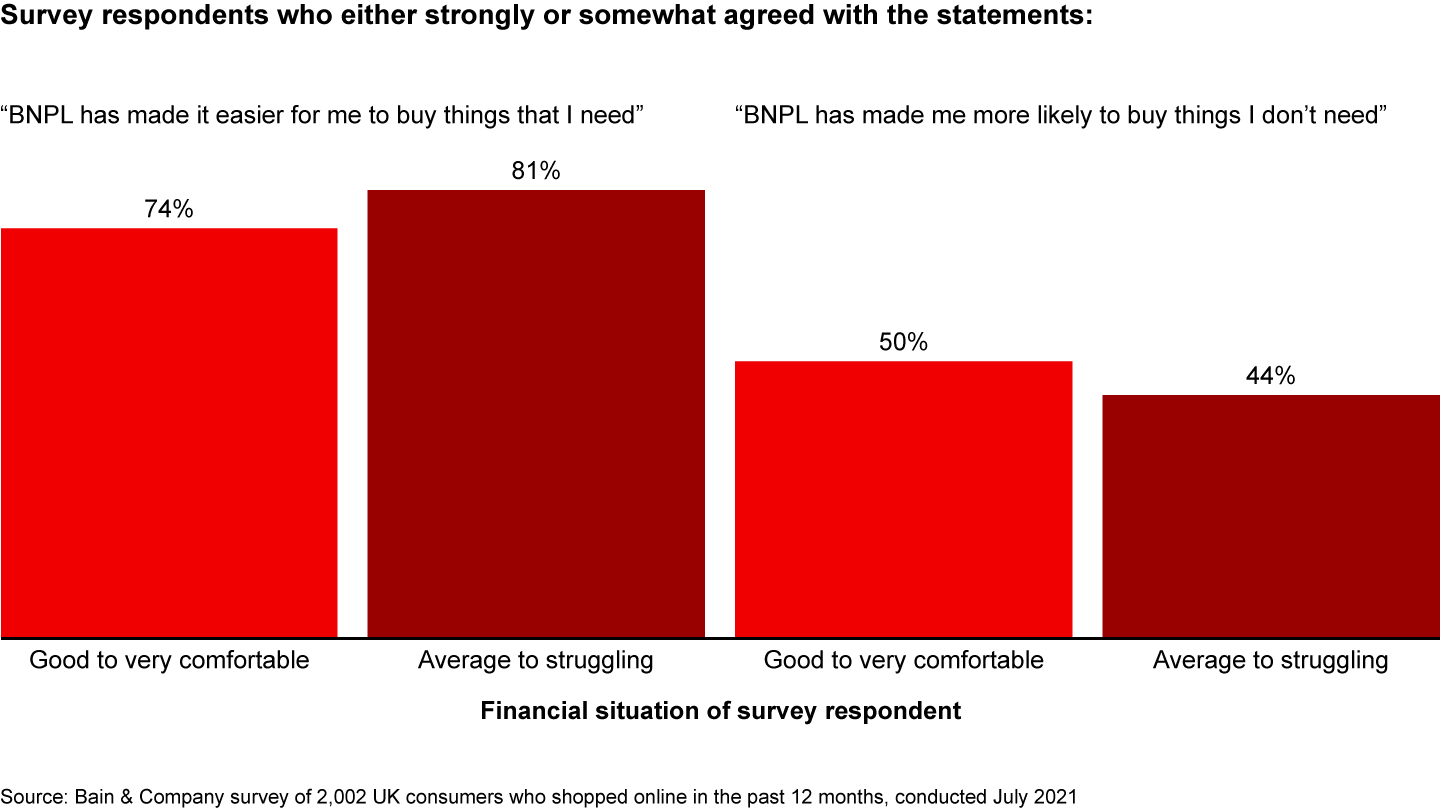

“It enables you to split the price into more manageable installments with no interest. What isn’t there to like?” —BNPL user
Making life more affordable. BNPL is becoming an important tool to make a range of goods and services more affordable. “Couldn’t afford the whole price of a purchase up front” was the third most common reason to buy through BNPL, with 34% of users selecting it as one of their top three reasons. This share was even higher among people from the lower end of the economic spectrum, with 48% selecting that reason. In short, people are using BNPL to unlock purchasing power.
Most BNPL users said they could easily afford their payments on time (see Figure 14). Even among people with fewer economic resources, 69% indicated they could easily afford payments, and 9% said they didn’t find them affordable. Data on missed payments supports this perspective: 69% of BNPL users said they had never missed a payment, and the share was 75% among respondents with lower financial standing (see Figure 15). Although the majority of users find BNPL affordable, the 9% who don’t merit the focus of providers and regulators in order to reduce that level over time.
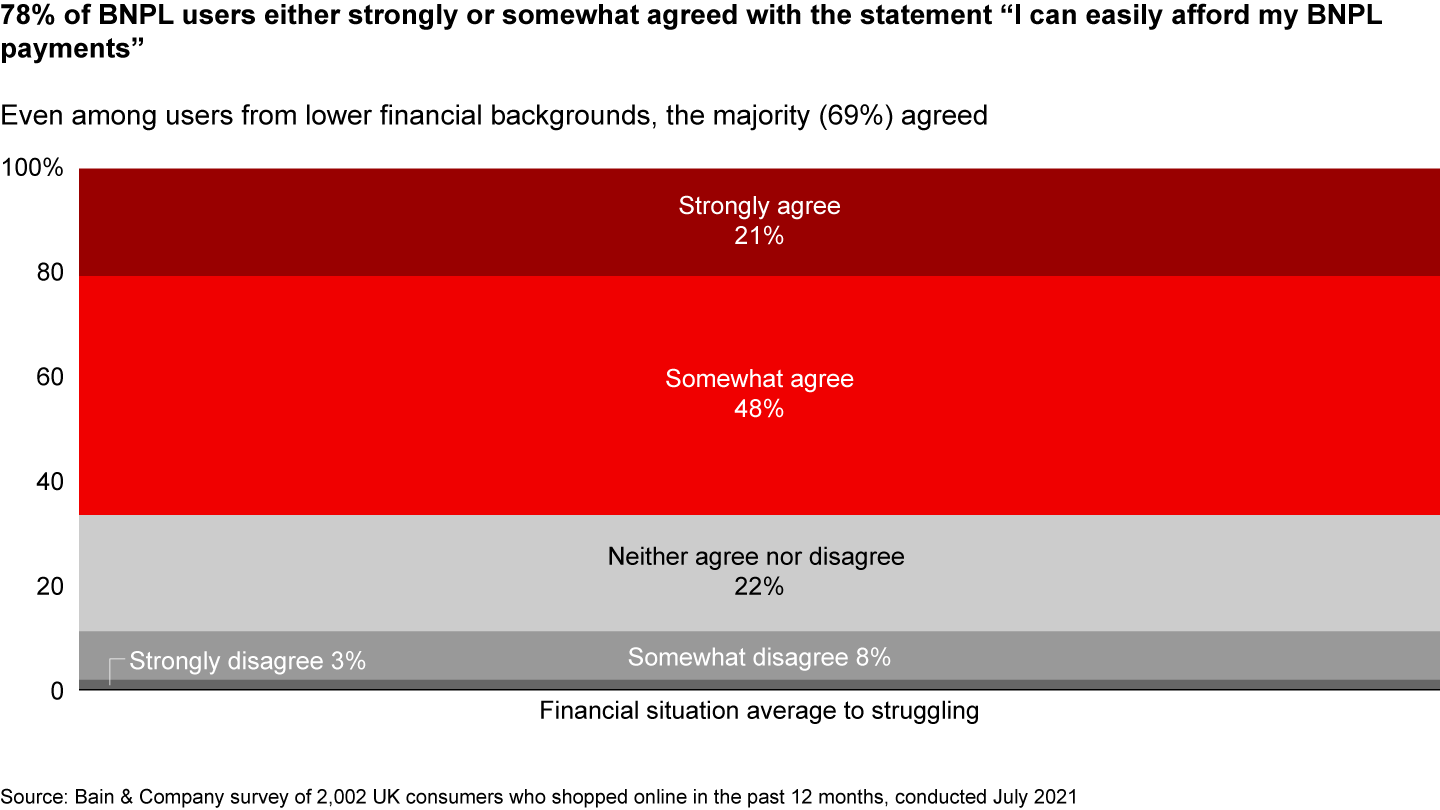

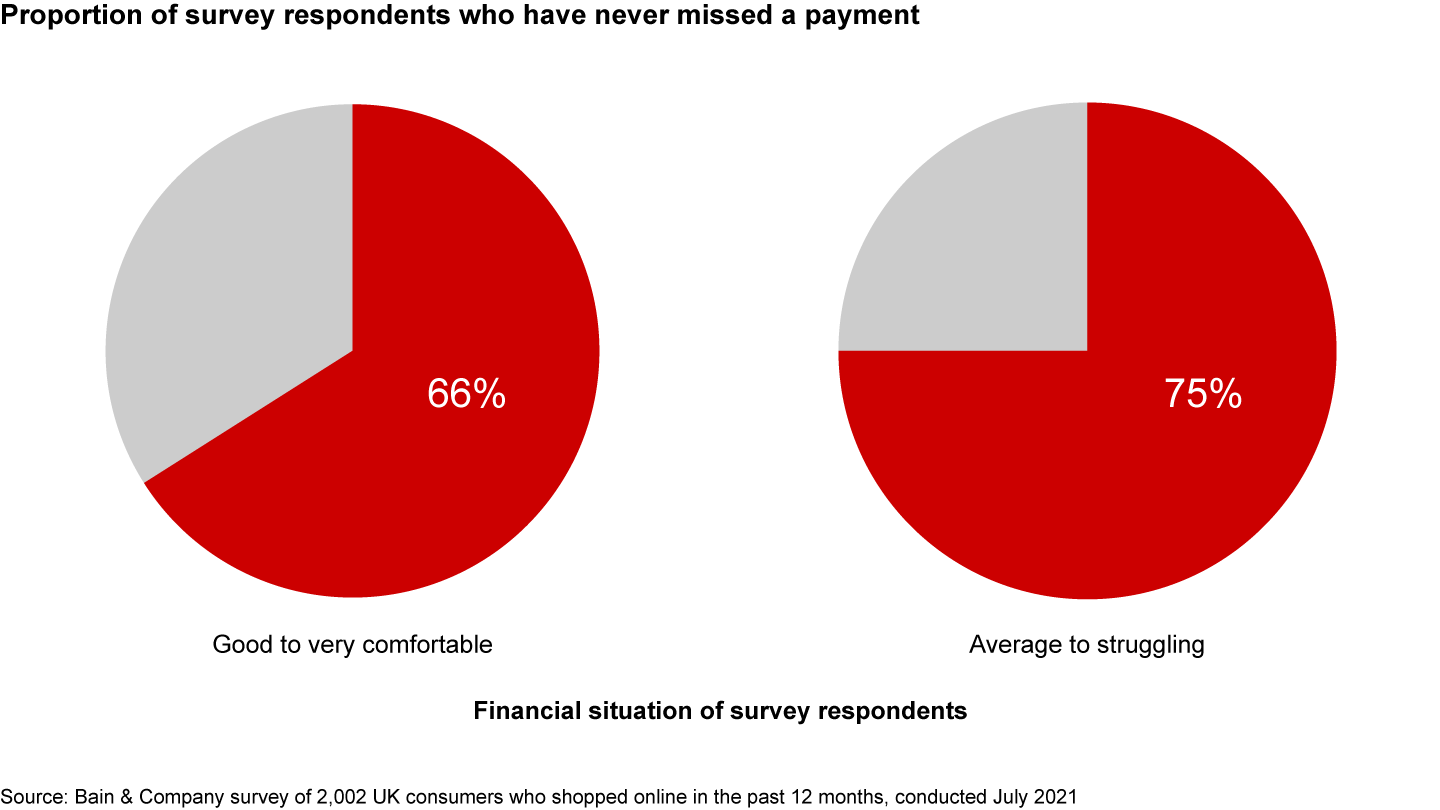

Convenience and ease of use. BNPL offers other benefits that combine to make a compelling proposition:
- Intuitive navigation and interface. Intuitive workflows, instant credit decisions, and an easy-to-use interface create an overall experience that resonates with younger, digital-native consumers. Functionality such as in-app reminders of upcoming payments, direct debits, and temporarily snoozing payments makes managing debts hassle-free and transparent.
- Wide availability. Presence at the point of purchase across a wide range of e-commerce websites has made BNPL a trusted, convenient alternative to credit cards.
- Discounts and offers. As BNPL apps become platforms where customers search and discover e-commerce items, merchants are beginning to use them as marketing channels where they offer discounts and promotions.
- Customer service. Service compares favorably against traditional credit products, as users can self-serve through a native chat functionality offered on BNPL apps and websites. In turn, this enables customer service agents to respond in a more targeted, helpful manner.
- Try before you buy. Many users still use BNPL to try purchases before being charged. If they return an item, they simply log on to their BNPL account and halt installments.
- Keeping track of online purchases. By linking transactions to specific items purchased, BNPL apps and websites make it easy for users to keep track of their online shopping. By contrast, bank or credit card statements typically display transactions only by merchant.
“[Provider] is a reputable, secure, quality brand with a good online website and app. It is easy to make payments and view your balance.” —BNPL user
The growth of merchant adoption
BNPL has been widely adopted by merchants in the UK. We estimate that approximately 20,000 merchants in the UK offer a BNPL checkout option (estimates exclude PayPal). The number of merchants offering BNPL is increasing, with BNPL volumes expected to grow 29% annually to account for 10% of all e-commerce spending by 2024. From larger retailers that are becoming more digital to small merchants competing to acquire customers, BNPL is supporting greater democratization in online retail. As an example, more than 90% of Klarna’s merchant partners in the UK are small and medium sized enterprises (SMEs) with under £2 million in annual turnover.
We interviewed executives from large online brands, specialty retailers, and smaller merchants to understand how they perceived the benefits of BNPL and what caused them to integrate these services. We also surveyed 104 merchants that use BNPL to quantify its effects. Broad adoption by consumers has led online shoppers to expect a BNPL option at checkout, 71% of merchants acknowledged. But the benefits of offering BNPL at checkout extend beyond responding to consumer preferences.
The speed of adoption is remarkable, with 92% of merchants surveyed having integrated their first BNPL solution since the start of the pandemic in early 2020. BNPL now accounts for 20% of sales from retailers offering BNPL, the same share of sales using digital wallets.
Many of the recent adopters are small retailers, half of which reported that BNPL played a significant role in helping them to endure very uncertain times. Furthermore, 75% of the surveyed merchants believe BNPL solutions will play a big role in their growth plans over the next year. What is it about BNPL that makes it so attractive to merchants?
The business benefits of BNPL
Listening to merchants describe their experience with using BNPL solutions, we identified nine benefits that we measured in the survey, grouped into the categories of sales, customer acquisition, customer experience, and costs (see Figure 16). Some 90% of merchants have experienced at least one benefit.
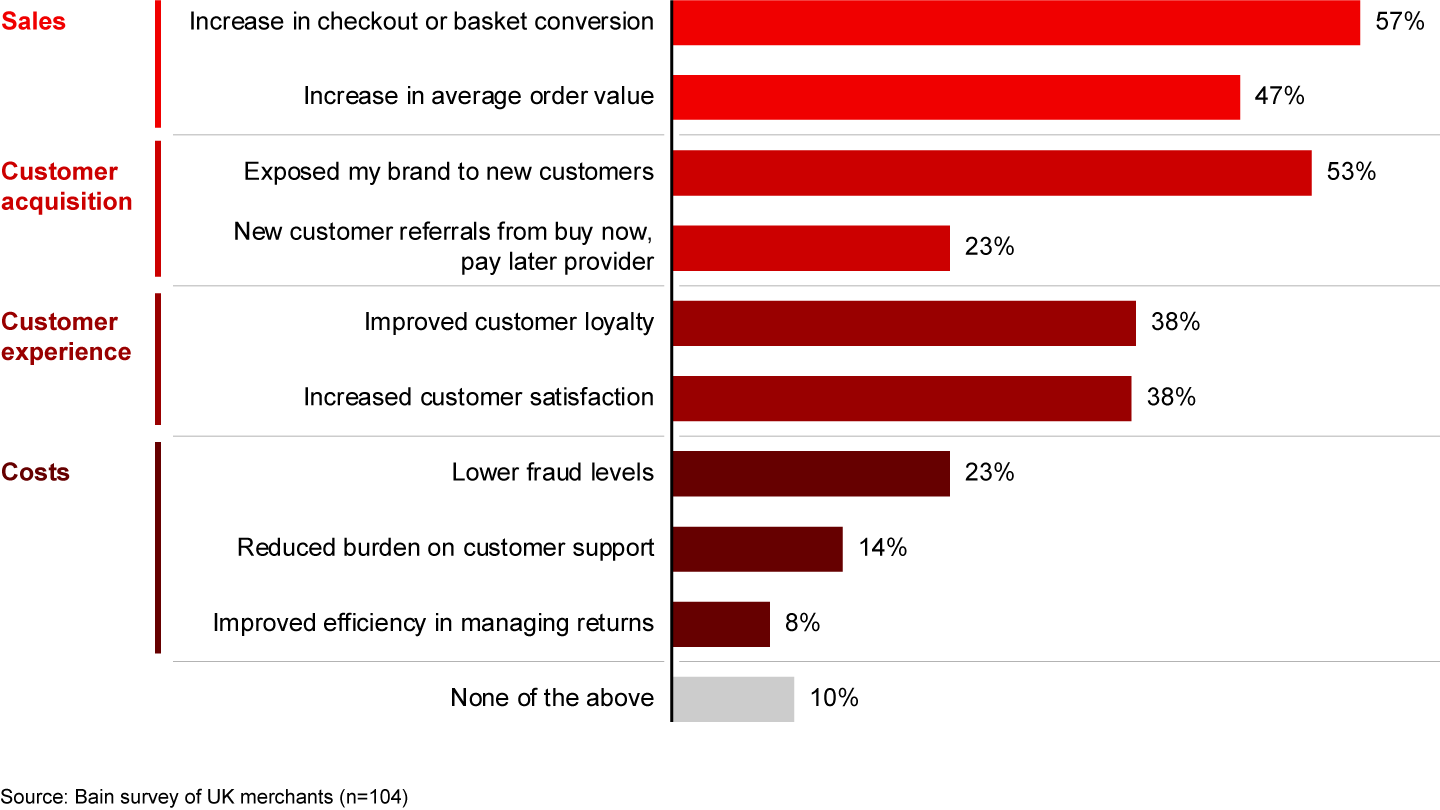

Sales
BNPL solutions can improve sales or checkout metrics in two ways:
Checkout or basket conversion. This was the most widely reported benefit, with 57% of merchants seeing improved conversion. Many online shoppers prize affordability, and flexibility of repayment helps to make a purchase more affordable. Consumers using BNPL are thus less likely to abandon their baskets.
Average order value. Some 46% of merchants surveyed experienced lifts in AOV, the third most prevalent benefit. Again, the benefits are circular. Consumers benefit from better managing their spending by spreading payments over multiple installments. This allows them to get what they need, resulting in larger baskets. With 78% of consumers surveyed easily able to afford their BNPL payments, the option benefits all parties in most instances.

Customer acquisition
Customer growth can be difficult to achieve in retail. The survey shows that BNPL providers boost merchants’ customer growth strategy in several ways:
Merchant brand exposure to new customers. Some 54% of merchants reported experiencing this benefit, the second-highest response. BNPL providers conduct a significant amount of advertising and marketing, which stimulates demand among consumers for BNPL services. Certain merchants also invest in co-branded marketing activities to boost awareness of their stores and reinforce the message that they offer BNPL at checkout.
Direct referrals of new customers from BNPL providers’ digital channels. This benefit applied to 23% of surveyed merchants, based on the BNPL provider listing the retailer partner on the provider’s website or app. While this benefit is experienced by fewer merchants than other benefits, we expect it to increase over time. BNPL providers occupy a strategically valuable position, having direct relationships with both merchants and consumers, and bringing the two together creates significant value and insight.
“The more the BNPL is recognized, the more likely customers will use it on your site; you also benefit from becoming part of the set of brands the customer base shops with.” —UK apparel merchant
Customer experience
Once a customer has visited a merchant, creating the best experience possible is essential to spreading word of mouth and motivating repeat business, and the convenient digital nature of BNPL checkout options add to the experience. This plays out in two ways:
Customer satisfaction. The survey found that 38% of merchants have experienced a rise in customer satisfaction since first offering BNPL as a checkout option. With 88% of the sample starting to use BNPL within the past 12 months, we have a high degree of confidence in this data.
Customer loyalty. Similarly, 38% of the merchants surveyed reported evidence of increased repeat purchasing from customers using BNPL. When you combine a good shopping experience with a fast, familiar checkout experience, customers will return.
Costs
Some merchants are experiencing cost-reduction benefits from BNPL as well.
Fraud levels. Compared to other forms of payment, 23% of merchants surveyed experienced less fraud with BNPL. As a proportion of sales, they had an average fraud rate of 1.5%, but with BNPL payments this fell to 0.6%. The BNPL provider takes on the full risk of payment and lending.
Customer support. Some 13% of merchants using BNPL solutions reported greater efficiencies for their support teams. Customers who use BNPL have relationships with the BNPL provider and the retailer. The providers have strong smartphone apps and customer support teams who can answer questions about payments, repayment dates, and order details.
Managing returns. Only 8% of merchants using BNPL reported this benefit. The status of returns and the refund of payments can be covered by the BNPL provider, easing the burden on the retailer. However, delivery and return of the product goes through a shipping company or the postal service, is coordinated by the retailer, and is handled by the warehouses they use. The many dependencies and third parties involved reduce the BNPL provider’s role.
How does the value to merchants stack up?
Every merchant has a cost to accept payments. On average, fees that smaller merchants incur for accepting Visa or Mastercard payments are around 1.5%. Fees charged by BNPL providers average 4.84% as reported by the merchants we surveyed, more than three times higher. However, with more than 90% of these merchants experiencing on average three of the benefits described above, it’s easy to see how the 3.3 percentage point difference can be made up.
When we spoke with merchants about their experiences, they consistently quoted 20%–30% lifts in AOV relative to credit card payments. This is consistent with a market survey by Zip. Even using the more conservative 20% lift in AOV, it makes sense for merchants to pay the extra fees for BNPL solutions at checkout (see Figure 17). The additional benefits of higher sales and lower costs make BNPL a compelling choice.


Clear benefits for merchants, but some price inflation for consumers
On average, merchants experience three benefits that increase sales or help cut costs, so BNPL is worth more than the fees charged for the majority of merchants.
However, we shouldn’t ignore the 10% of merchants that report no benefits from using BNPL solutions or the fact that benefits lead to higher prices for consumers. In our merchant survey, about 30% of respondents had increased the price of their products due to the fees charged by BNPL providers. Among those retailers, prices increased an average 4%–5%. Consumers using one of these merchants are paying for the lending, one way or another.
BNPL’s data and insight benefits
BNPL does not only produce monetary benefits. Because the providers have relationships with consumers and merchants, they often generate powerful insights from the data exhaust of those two groups. By being present from the initial search and discovery on BNPL apps and websites to the checkout and payment, providers can provide merchant partners with valuable data on several fronts:
- Who their customers are. With data such as age, gender, location, and credit score from their BNPL provider, merchants can better understand their target customer segments.
- The types of products customers prefer. Providers can aggregate data on past purchases, items viewed and saved, time spent browsing, and social sharing. Merchants can use the data to segment customers and help send targeted marketing.
- Where they shop. Repeat purchases and in-app engagement can be used to understand loyalty and tailor offerings to meet customer needs.
From the consumer and merchant research conducted by Bain, clear benefits accrue. BNPL helps merchants grow sales, acquire customers, cut costs, and gain better insights on their customers.

Risks and challenges
Like any form of payment or credit, BNPL comes with risks that must be managed. We’ll explore three of the most commonly cited challenges.
Risk of debt spirals across multiple BNPL providers. Perhaps the main challenge for BNPL companies is protecting customers from overuse across multiple providers, be it intentional or inadvertent. Because these services can be easily accessed and providers currently cannot share data with each other through credit reference agencies (CRAs), there’s a significant risk of users racking up unaffordable debt. As highlighted in the Woolard Review, there is also a perception that “some consumers don’t view BNPL as credit” owing to the “zero cost” nature (among other things), creating a risk that consumers might not apply the same level of scrutiny as they do on traditional forms of credit.
In our survey, 58% of BNPL users aged 18–24 and 49% of those aged 25–34 agreed with the statement “BNPL services … do not qualify as debt because they don’t charge interest.” However, our research suggests this view doesn’t translate into irresponsible usage and unaffordable indebtedness. Moreover, recently released guidelines from the UK Advertising Standards Authority (ASA) have been welcomed by industry participants. These guidelines require BNPL providers advertising their products to clearly state that their services are a form of credit that might not be suitable for all and can affect credit scores.
We calculated how much UK online shoppers owed on BNPL accounts, credit cards, and overdrafts. The great majority had balances under £100 across all BNPL providers (see Figure 18). For credit cards and overdrafts, we found that 43% of users have balances above £300 (compared with 18% of BNPL users) and 21% have an open balance of more than £1,000 (compared with only 3% of BNPL users).
We also asked BNPL users how many different BNPL accounts they have an open balance on. Even here, the results were encouraging, as 73% indicated they had an open account with either one or no providers at the time of completing the survey.
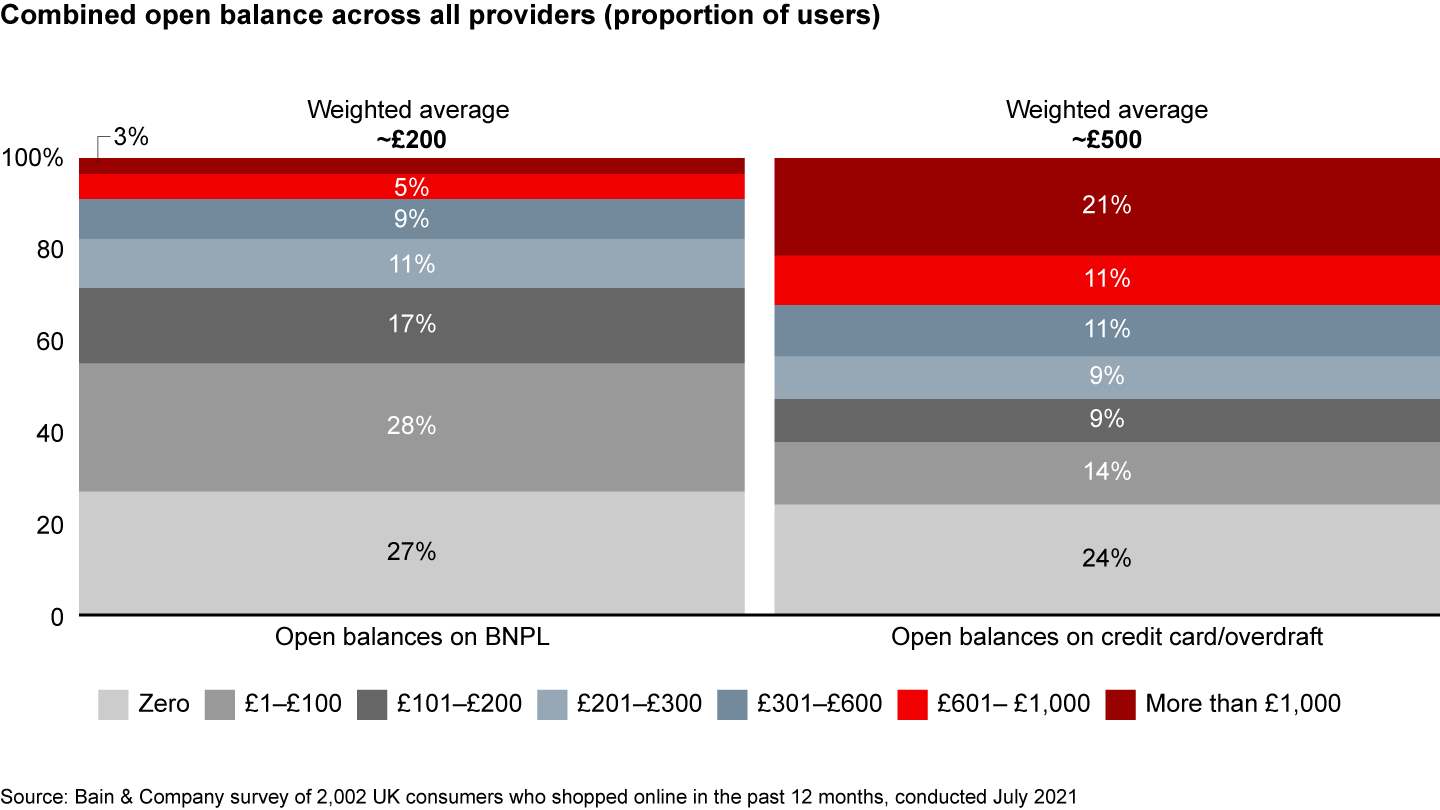

That said, as BNPL adoption and usage continues to expand and reach larger individual purchases, it is possible that average balances and the resulting costs to consumers (such as in late payment fees) will grow. There is a long tail of at-risk users. For example, 6% of users in our survey had an open balance across three or more providers, and 10% said one of their top three reasons for using BNPL was that they had maxed out their credit card limit. Effective mechanisms to limit such customers from incurring too much debt will help create a sustainable BNPL ecosystem. Klarna, Laybuy, Openpay, and others are exploring integration with CRAs as a possible way to obtain better data on borrowers. Open Banking also offers promising pathways to assessing affordability, which will further reduce risk for borrowers and lenders alike.
In most cases, the affordability of BNPL is similar to credit cards. Our survey suggests that 78% of users find their repayments to be easily affordable, compared with 82% of credit card users. And when we compare BNPL users with consumers at a lower financial standing, a larger proportion tend to find BNPL slightly more affordable than credit cards (see Figure 19).
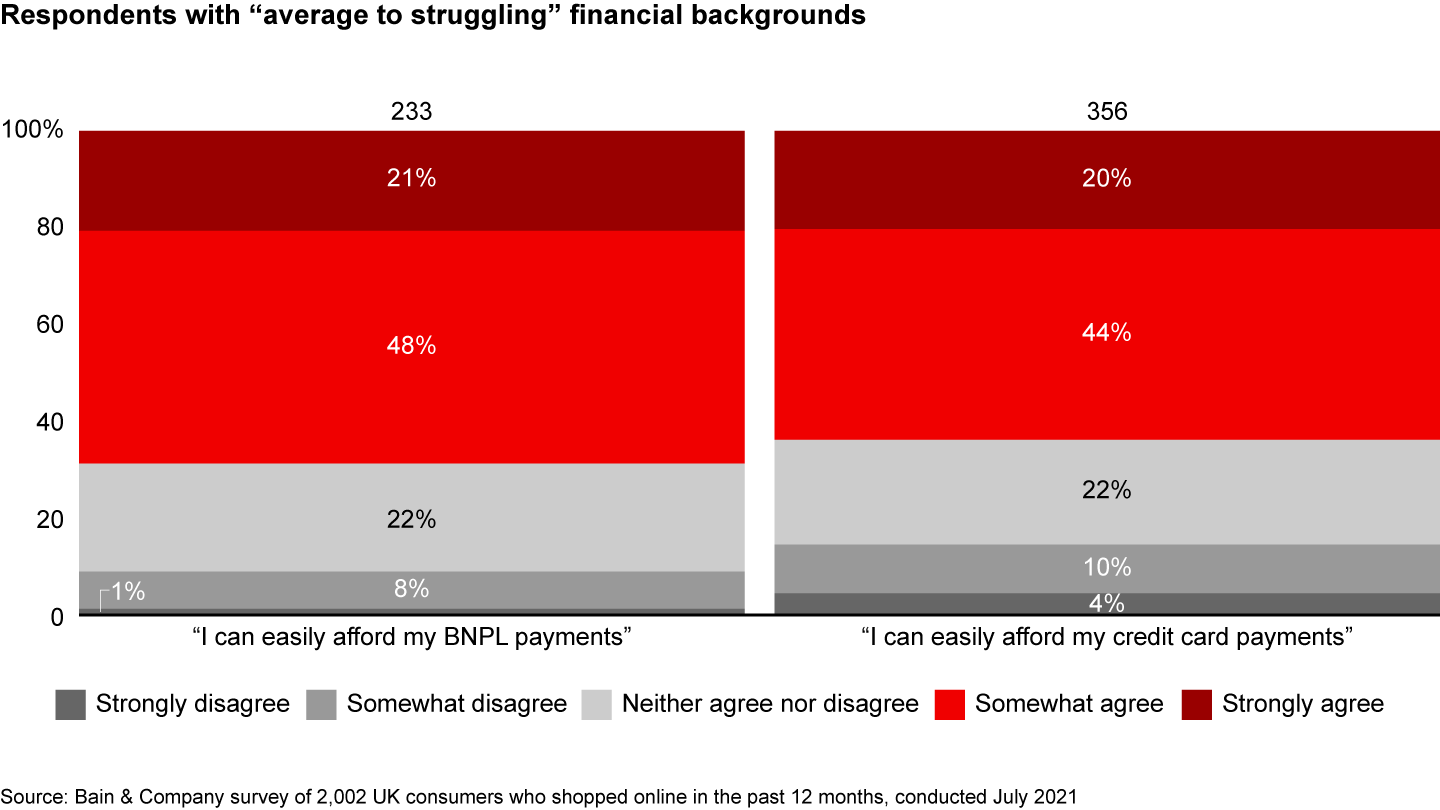

Therefore, in most cases, the risk of someone getting stuck with unaffordable BNPL debt is low. But these small at-risk groups require the most attention. While 9% of average or struggling consumers who can’t easily afford BNPL repayments sounds like a low number, providers and regulators should work to reduce this level further. Here, BNPL providers have controls in place. A user’s eligibility is assessed at every transaction, and credit limits are adjusted based on past timely repayments. People who leave installments unpaid are usually barred from further usage, and as a result, irresponsible borrowers are automatically prevented from incurring additional debt.
However, BNPL brings a level of seamlessness that can blur the lines between payment method and form of borrowing. Engaging user experiences are generally a good thing, but they can come with potential harms (as we’ve seen with other consumer technology products). Proportionate and timely regulation that adds a small degree of positive friction, such as the disclaimers mandated by the ASA guidelines, can help mitigate the risk of misuse and create an environment in which responsible practices become the norm.
Risk of defaults and missed payments. We asked users of BNPL and credit cards about their outlook and frequency of missed payments. Some 41% of BNPL users either strongly or somewhat agreed with the statement “I am worried about missing payments on my BNPL purchase,’’ whereas only 30% agreed with an analogous statement about credit cards. While this is not surprising given that credit cards require much smaller monthly minimum payments, it still reflects a material degree of repayment anxiety among BNPL users.
We further tested the reasons that users tend to miss payments. While the overall frequency of missed payments was higher for BNPL, for those who have missed multiple payments, not being able to afford a payment was more commonly cited as a reason with credit cards and overdrafts (Figure 20). In our discussions with BNPL providers, we found that BNPL default rates were low but varied across providers, ranging from under 1% for Klarna and Afterpay Global to a maximum of 5% of gross transaction value.


By comparison, default rates on UK credit cards amounted to 0.8% of gross lending in 2020 (although these could rise as stimulus schemes expire). However, according to the FCA, roughly 5% of credit card users were also in persistent revolving debt, paying more in fees and interest than in repayments. That differs from BNPL, where users who miss payments are typically barred from making further purchases and incurring additional debt. The absence of interest combined with caps on a late fee means that providers have no incentive to serve people who are unable to repay. BNPL providers told us that up to 40% of orders are fully repaid early, although this varies across companies.
Turning to the overall contribution of late fees to total income, while high for some BNPL providers, it has been declining steadily. (Klarna, the largest provider, does not charge a late fee to UK customers, and PayPal is removing late fees on new purchases beginning October 1, 2021.) Our survey found that 52% of BNPL users (excluding Klarna) who had missed a payment were charged a late fee, compared to 62% of credit card users. This might mean that BNPL users are more likely to quickly rectify a missed payment, despite minimum payments on credit cards being much smaller than a BNPL installment. It also reflects the greater level of transparency that BNPL companies provide to users.
52% of BNPL users who had missed a payment were charged a late fee, compared to 62% of credit card users.
BNPL companies generally do not depend on late fees to break even, but a reasonable and capped late fee can help deter misuse. Such penalties should also be combined with user education on the consequences of missing payments. Reports suggest that BNPL users who have missed payments are sometimes caught off guard when these are reported to CRAs, affecting their credit score and future ability to borrow. Better awareness of such matters will help drive down defaults while encouraging healthy and sustainable borrowing behavior.
Impulse purchasing and vulnerable users. Another common criticism of BNPL has claimed that it appeals disproportionately to young, financially vulnerable individuals who are prone to irresponsible spending. We tested these points in our survey and found that BNPL adoption was consistent across income groups, except among people with less than £20,000 in gross household income, where adoption was significantly lower than average. Usage was also not as heavily concentrated among millennials as is often believed, with meaningful adoption even among people aged 45–54 (see Figure 21). These facts provide more evidence of a genuine mass market and also suggest that lower-income consumers are less likely to use BNPL.
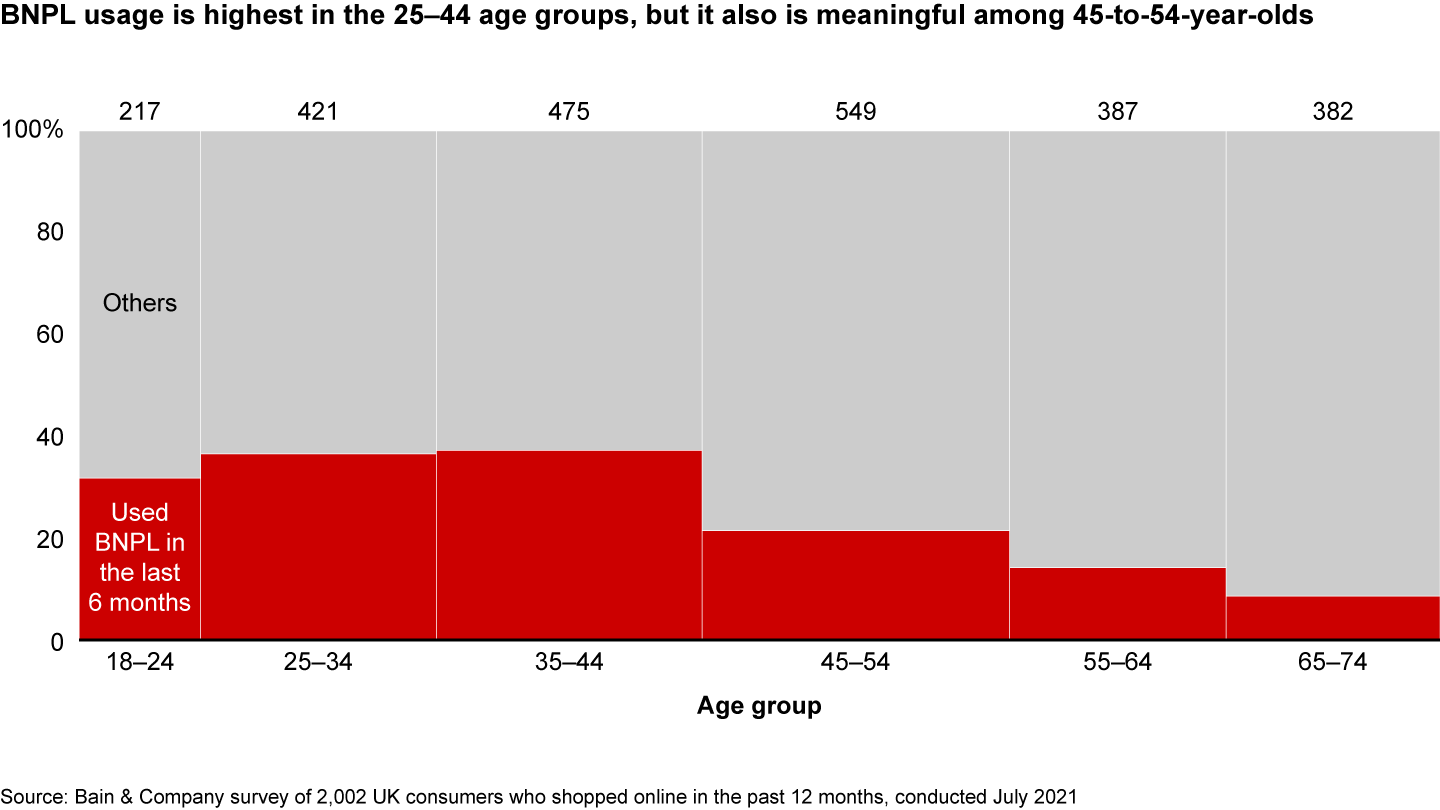

Regarding impulse purchases, we tested the likelihood of consumers to do this online by scoring survey respondents on their reactions to the following statements:
- “When shopping online I often end up purchasing items that I wasn’t originally planning on buying.”
- “I often spend significantly more money than planned when I shop online.”
Younger people with access to more than one form of credit are generally the most likely to make purchases on impulse. On average, credit card users tend to be slightly more conservative spenders than BNPL users (see Figure 22). This is not unexpected; BNPL usage remains narrower than credit card usage, skews toward discretionary e-commerce purchases, and credit cards are more common among older people, who tend to be more conservative spenders.
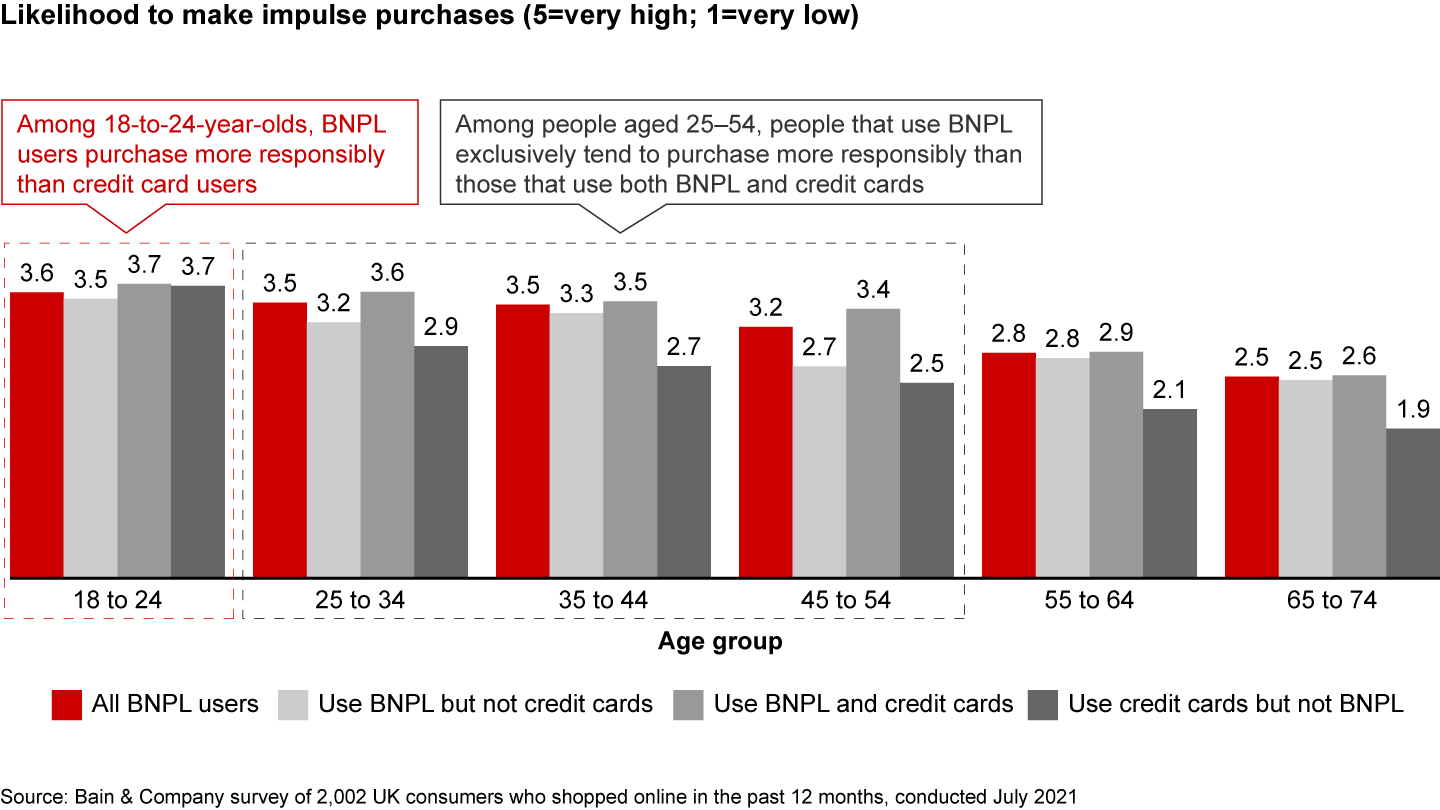

An appreciable minority of BNPL users feel anxious about being able to repay and believe that BNPL can encourage unnecessary spending. We thus see a case for implementing additional support measures for vulnerable users and incorporating affordability assessments into the underwriting process. Fortunately, providers in the UK have actively been addressing these issues. Last year, Klarna launched its KlarnaSense program that seeks to educate consumers around shopping responsibly by asking, “Do I love it? Will I use it? Is it worth it?” Clearpay, PayPal, Laybuy, and Zip, among others, offer confidential hardship assistance programs that involve a combination of postponing or rescheduling payments and capping or waiving some or all late fees.
Summing up the benefits and risks, then, BNPL holds its own relative to credit cards (see Figure 23).